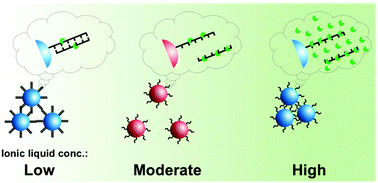Plasmon switching of gold nanoparticles through thermo-responsive terminal breathing of surface-grafted DNA in hydrated ionic liquids†
Abstract
Self-assembly performed in ionic liquids (ILs) as a unique solvent promises distinct functions and applications in sensors, therapeutics, and optoelectronic devices due to the rich interactions between nanoparticle building blocks and ILs. However, the general consideration that common nanoparticles are readily destabilized by counterions in an IL has largely prevented researchers from investigating controlled nanoparticle assembly in IL-based systems. This study explores the assembling behaviour of double-stranded (ds) DNA-functionalized gold nanoparticles (dsDNA–AuNPs) in hydrated ionic liquids. The DNA base pair stacking assembly of dsDNA–AuNPs occurs at a low IL concentration (<5%). However, a moderate ionic liquid concentration (5–40%) can de-hybridize dsDNA and leaves single-stranded (ss) DNA stabilizing the AuNPs. In concentrated ionic liquids (>40%), interestingly, the higher ionic strength leads to the assembly of DNA–AuNPs. The triphasic assembly trend is also generally observed regardless of the type of IL. By down-regulation of DNA's melting temperature with the IL, the assembly of DNA–AuNPs affords robust response to a lower temperature range, promising applications in plasmonic devices and range-tunable temperature sensors.



 Please wait while we load your content...
Please wait while we load your content...